During the warmer months, it’s common to see hummingbirds flitting around flowers in search of nectar. Their fast, hovering flight and ability to fly in all directions makes them a joy to watch.
But what happens to these tiny birds when the skies open up, and the rains come pouring down?
As a hummingbird lover myself, I was curious to find out where hummingbirds seek shelter during summer rainstorms. Let’s explore the answer in this blog post!
In this blog post, we will cover:
- Where Hummingbirds Go When It Rains
- Why hummingbirds need to take shelter in bad weather
- The different places they go to stay dry
- How rain impacts their behaviour and survival
- If all species react the same way to storms
- How we can support hummingbirds during prolonged rainfall.
Where Do Hummingbirds Go When It Rains?
When it rains, hummingbirds seek shelter under thick trees, shrubs, and broad-leafed branches. They may also find refuge under the eaves of buildings or inside open garages. They perch in sheltered spots during heavy rainfall, conserving energy until the rain subsides.
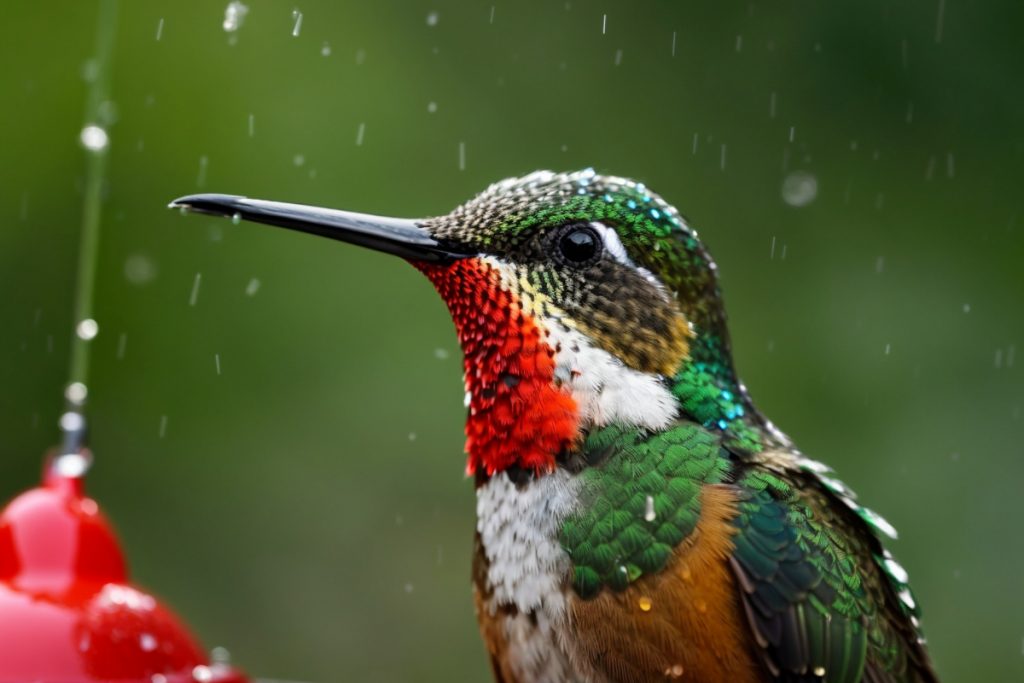
Related post to read about Best Hummingbird Feeders.

Why Hummingbirds Need To Take Shelter In Bad Weather
Hummingbirds Are Vulnerable To Getting Soaked
With an average weight of just 3-5 grams and bodies 4-5 inches long, hummingbirds are tiny creatures. Their small size, unfortunately, makes them vulnerable when the weather takes a turn for the worse.
When hummingbird feathers get soaked by rain, it affects their ability to thermoregulate and maintain body heat. Wet feathers also become heavier, requiring more energy during flight.
With their high metabolisms, hummingbirds need to consume the equivalent of their body weight in nectar each day just to survive.
If rain prevents them from accessing food sources, they can quickly become hypothermic and starve. So when the clouds burst, getting to shelter becomes critical for their survival.
So, to put it into a better context:
Hummingbirds consume a substantial amount of nectar to support their high-energy lifestyles.
On average, a hummingbird will drink its body weight in nectar each day. To achieve this, they might visit hundreds or even thousands of flowers daily, depending on the availability and sugar content of the nectar in the flowers they are visiting.
It’s important to note that the exact number of flowers a hummingbird needs to visit can vary widely based on factors like the species of hummingbird, the type of flowers they’re feeding from, the quality of the nectar, and the bird’s energy needs for the day.
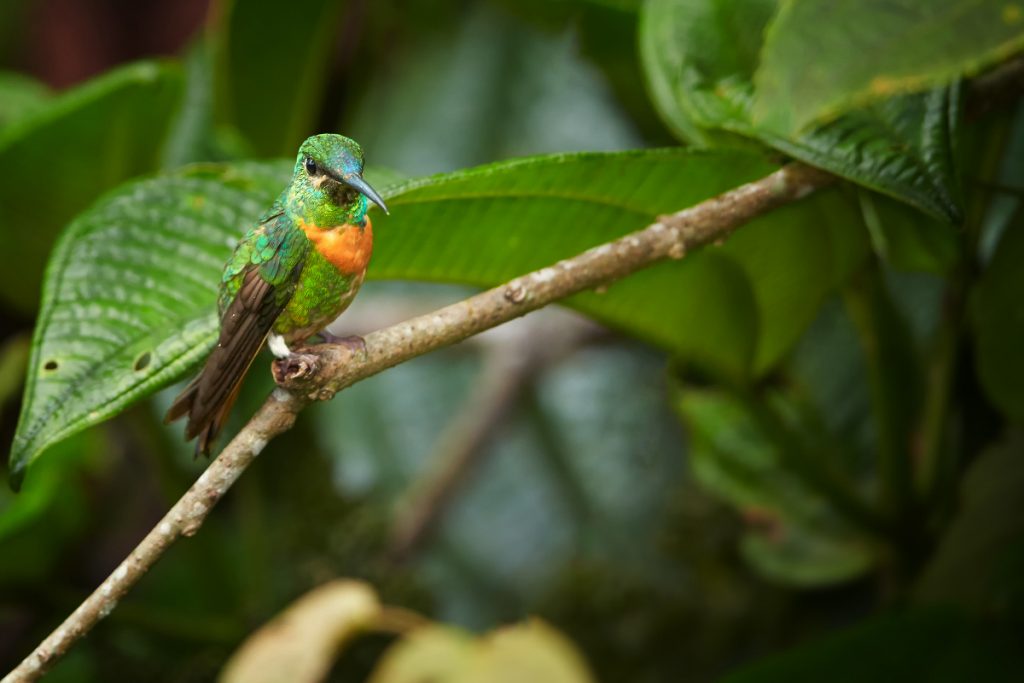
The Different Places They Go To Stay Dry
Trees, Porches, And Garages Make Good Shelters
When caught in the rain, hummingbirds will seek any shelter they can find to stay dry. Thick trees and shrubs are a natural, safe haven during light to moderate rainfall.
Broad-leafed branches help block raindrops, allowing hummingbirds to perch underneath relative cover. If available, many hummingbirds will also dart under the leaves of buildings, patios, or porches to escape a downpour.
I’ve even had hummingbirds suddenly appear inside my open garage, hovering there temporarily to avoid getting drenched by heavy rain.
While not an ideal long-term solution, garages and sheds can provide life-saving emergency shelter when storms strike suddenly.

How Rain Impacts Their Behaviour And Survival
Rain Causes Behavioural Changes In Hummingbirds
The onset of rain triggers certain behavioural changes in hummingbirds to help conserve energy. Because their saturated feathers make flying more laboured, they tend to remain perched in one spot when it’s raining steadily.
Entering a temporary state of torpor, their metabolism and body temperature drop to expend less energy during the storm. They appear lethargic, with puffed-up feathers and eyes closed. Hummingbirds also stop feeding when it rains heavily.
With their blurred vision and the challenge of flying in the rain, they opt to rest and wait it out.
Once the rain passes, the hummingbirds become active again, returning to their regular feeding schedules and behaviours.
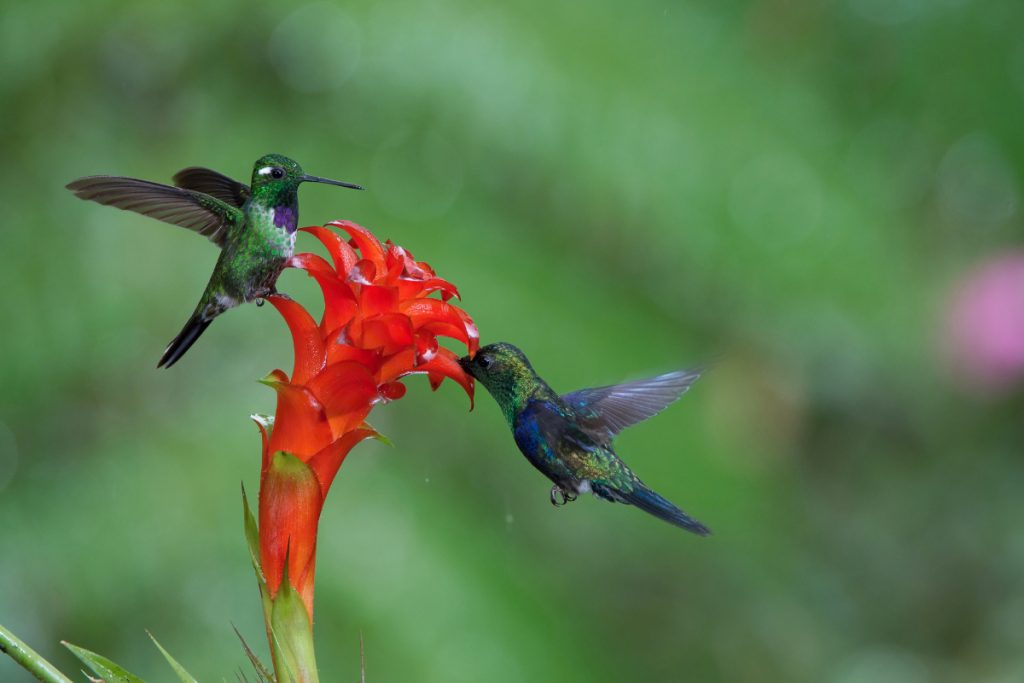

If All Species React The Same Way To Storms
Storms Can Negatively Impact Hummingbirds
While periodic rainfall is normal, extreme weather like thunderstorms, hurricanes and fronts can have negative impacts on hummingbirds. Prolonged heavy rain forces hummingbirds to halt feeding for extended periods when they require frequent nourishment.
If a migrating hummingbird gets caught in a major storm system, it can blow them dangerously off course and deplete their limited energy reserves making the journey.
Even brief delays reaching food sources along their migration routes could prove catastrophic. Non-migratory hummingbirds also face life-threatening challenges from major weather events that hit their breeding grounds.
Days of endless rain limit food intake and can lead to reproductive failure if the birds are tending nests.
Species And Locations Make A Difference
Not all hummingbird species react in the same way when rain arrives. In tropical regions, rainfall is more intermittent and brief compared to temperate locations. Tropical hummingbirds have evolved with this pattern.
When short, heavy downpours occur, they may just shelter momentarily before resuming normal behaviours once it drips to a light drizzle.
However, temperate hummingbirds that breed where long rainy periods are common have adapted to handle extended bad weather. It’s not unusual for them to exhibit lethargic traits and fast for a day or two until major rainstorms pass.
Species that migrate long distances are also more vulnerable to rain disrupting their journeys.
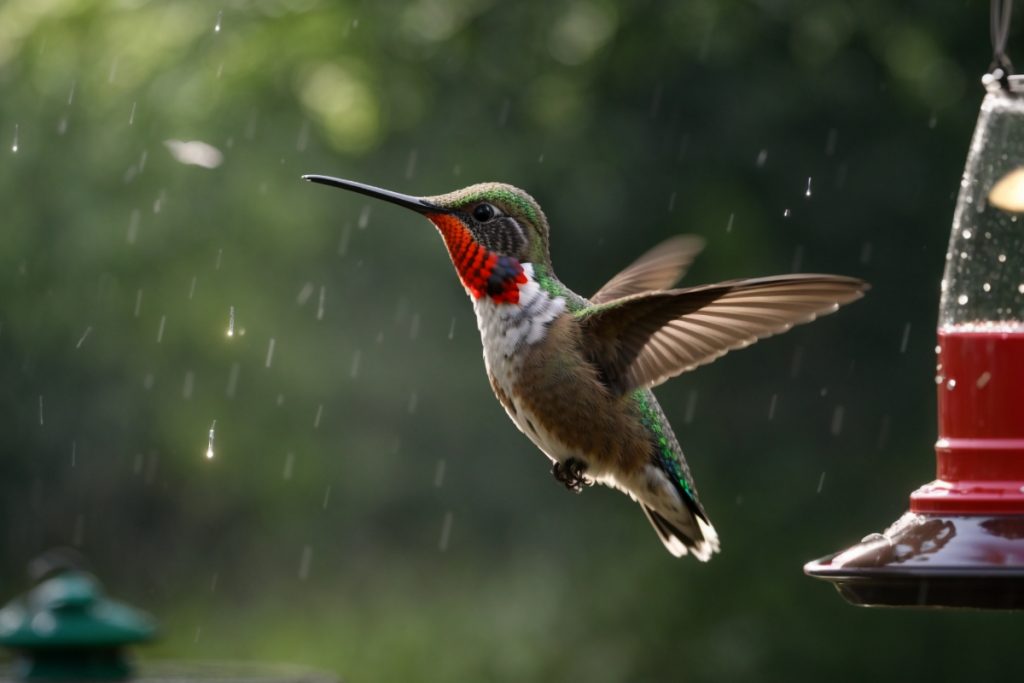
How We Can Support Hummingbirds During Prolonged Rainfall
How You Can Help Hummingbirds In The Rain
During extended wet periods, we can help support hummingbirds in our yards by:
- Ensuring feeders are full and positioned undercover
- Planting nectar flowers and shrubs near protected areas
- Providing makeshift shelters like trellises or mesh tents
- Leaving fresh water available for bathing and drinking.
With some planning, we can help hummingbirds survive and thrive even when the skies open up!
Conclusion
Rainstorms are a fact of life, but hummingbirds have adapted amazing survival skills to cope with such situations. Their small size makes them vulnerable, but they can wait out the worst by seeking shelter in trees, buildings, and other covered spots.
While major storms do pose risks, periodic rainfall causes more temporary behavioural changes like torpor and fasting. Once the clouds clear, hummingbirds immediately resume their regular feeding and activities.
With extra care from us, these remarkable little birds continue bringing their beauty and wonder even on the rainiest of days. The least we can do is support them in any way we can, no matter how little.
Thanks for reading, and I hope you found this article helpful.
Also, before you leave, we would appreciate it if you could share your comments in the comment section below. We would love to learn from your experience because every piece of knowledge counts.

FAQs on – Where Do Hummingbirds Go When It Rains?
Q: How do hummingbirds find a source of food during rainy weather?
A: During wet weather, hummingbirds rely on their knowledge of local nectar sources, including flowers and hummingbird feeders, to find food.
Q: Where do hummingbirds take shelter during light rain?
A: In light rain, hummingbirds often seek shelter under the canopy of trees, dense shrubs, and other sheltered spots.
Q: How do hummingbirds adapt their flight patterns during inclement weather?
A: In adverse weather conditions, hummingbirds might reduce their flight activities, perch in sheltered spots, and conserve their precious energy.
Q: What happens to the metabolic rate of hummingbirds during moderate showers?
A: During moderate showers, hummingbirds may enter a state of torpor, reducing their metabolic rate to conserve energy.
Q: How fast is the wing speed of a hummingbird during normal weather?
A: The wing speed of a hummingbird during normal weather averages between 50 to 75 beats per second, with specific rates varying based on species and other factors. During courtship flights, both ruby-throated and rufous hummingbird wings can beat up to 200 times per second, producing the characteristic humming sound they are known for.
Q: Are bird feeders beneficial for hummingbirds during wet weather?
A: Yes, bird feeders, especially hummingbird feeders filled with sugar water, provide an essential source of food during wet weather when natural nectar might be scarce.
Q: How do larger birds compare to adult hummingbirds in rainy weather behaviour?
A: While larger birds might also seek shelter during rain, adult hummingbirds are particularly vulnerable due to their small size and high energy needs, making them more affected by rainy weather.
Q: How do hummingbirds cope with extreme weather conditions like hurricanes over land?
A: In extreme weather conditions, hummingbirds seek the most sheltered spots they can find, often in dense vegetation or on the downwind side of a tree trunk. Severe storms can have adverse effects on their migration and feeding patterns.
Q: Are hummingbirds considered a hardy type of bird?
A: Yes, hummingbirds are hardy birds, having adapted amazing survival skills to cope with various weather conditions.
Q: How do the species of birds affect their reaction to rain?
A: Different species, like the ruby-throated hummingbirds or tropical hummingbirds, have varied reactions to rain based on their natural habitats and evolutionary adaptations.
Q: Where does the hummingbird sleep during a rainy night?
A: Hummingbirds will find a sheltered spot, often in dense shrubs or trees, to rest during a rainy night.
Q: How do wet hummingbird wings affect their flight?
A: Wet wings can make flying more difficult for hummingbirds, requiring more energy and affecting their efficient flight.
Q: What trees for hummingbirds are best during bad weather hits?
A: Trees with dense foliage and broad-leafed branches are ideal for hummingbirds when bad weather hits as they offer more protection.
Q: How do hummingbirds maintain body position during strong winds?
A: Hummingbirds have strong feet that allow them to grip onto twigs and branches tightly during strong winds, ensuring they maintain their body position.
Q: Why is it essential to keep hummingbird feeders clean during wet weather?
A: Keeping feeders clean ensures that the sugar water or nectar remains uncontaminated, providing a safe and reliable source of food for hummingbirds during wet weather.
Q: How do hummingbirds manage their energy for efficient flight during cold weather?
A: In cold weather, hummingbirds conserve energy by reducing their heart rate, entering torpor, and relying on stored fat reserves to maintain efficient flight.
Useful Links:
Related Posts to Read – Hummingbirds Migrations:
- Best Hummingbird Feeders.
- When Do Hummingbirds Leave Ohio?
- When Do Hummingbirds Leave Michigan?
- When Do Hummingbirds Leave Pennsylvania?
- When Do Hummingbirds Leave Florida?
- When Do Hummingbirds Leave Oregon?
- When Do Hummingbirds Leave New York?
- When Do Hummingbirds Leave Oklahoma?
- When Do Hummingbirds Leave Minnesota?
- When Do Hummingbirds Leave South Carolina?
Related Posts to Read:
- Do Hummingbirds Beaks Open When Feeding?
- The Mysteries of Hummingbird Flight.
- 6 Fascinating Facts About Hummingbird Sizes.
- Ruby-Throated Hummingbird Migration Map.
References:
- About Hummingbird (Link).
- Greenewalt, C. H. (1960). Hummingbirds. New York: Doubleday. Google Scholar.
- Carey C. The impacts of climate change on the annual cycles of birds. Philos Trans R Soc Lond B Biol Sci. 2009 Nov 27; 364(1534):3321-30. doi: 10.1098/rstb.2009.0182. PMID: 19833644; PMCID: PMC2781852.
- Rico-Guevara A, Rubega MA, Hurme KJ, Dudley R. Shifting Paradigms in the Mechanics of Nectar Extraction and Hummingbird Bill Morphology. Integr Org Biol. 2019 Jan 2;1(1):oby006. doi: 10.1093/iob/oby006. PMID: 33791513; PMCID: PMC7671138.
- Tyrrell LP, Goller B, Moore BA, Altshuler DL, Fernández-Juricic E. The Orientation of Visual Space from the Perspective of Hummingbirds. Front Neurosci. 2018 Jan 30;12:16. doi: 10.3389/fnins.2018.00016. PMID: 29440985; PMCID: PMC5797624.
- Hummingbirds Sighting (Journey North Map).
- About Hummingbird’s Characteristics.
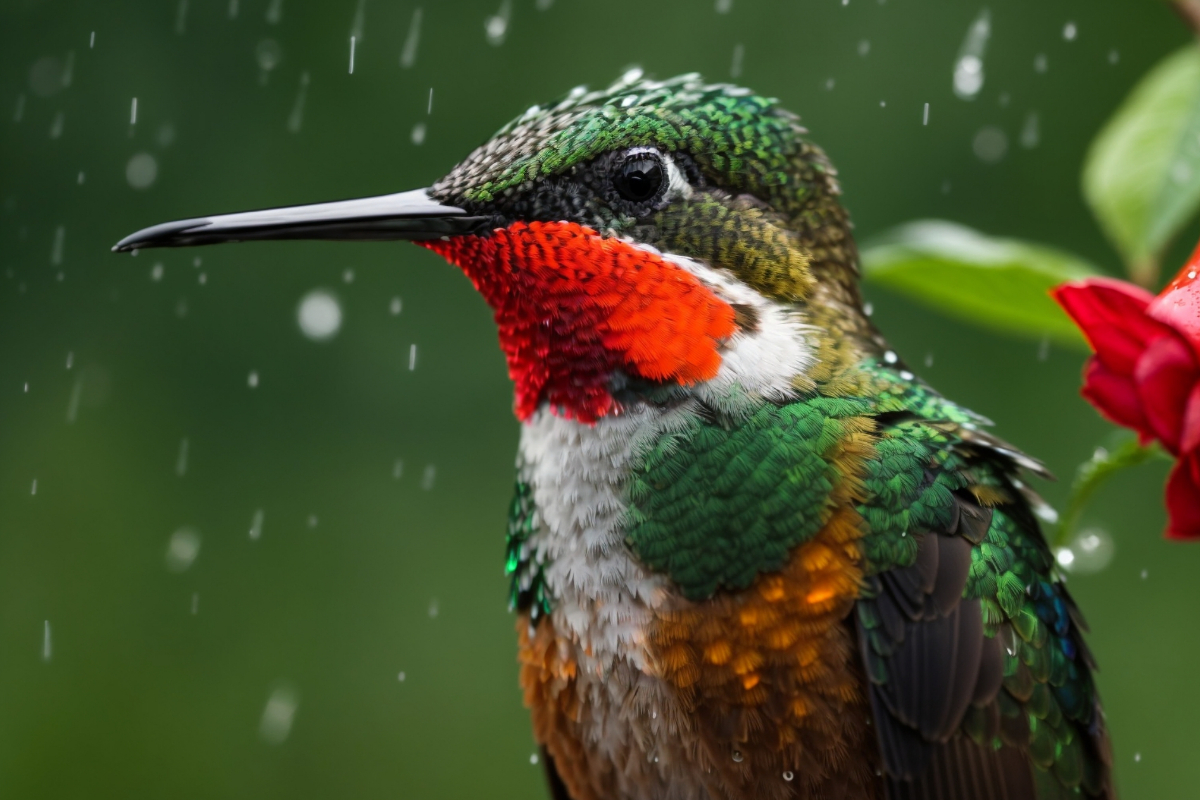
I haven’t seen as many hummingbirds this year. I am planting new plants like a “Blue Bird” Rose of Sharon, and Cosmos, in addition to the 16 feet of Zinnias and 2 Butterfly Bushes. I got scared when I heard about the possibility of killing them by keeping the sugar water out too long (bacteria), and with all my mother-in-law’s health issues, I couldn’t commit to washing the feeders every 1-2 days when the heat got over 100 degrees, so when I didn’t see any hummingbirds in March or April, I took my feeders down in May and didn’t put them up again until Sept for the Fall Migration. I later heard that the Spring Migration was later this year than normal going thru Oklahoma. So next year, I’ll go ahead and do feeders from April thru October. Even though I haven’t seen any hummingbirds for 3 weeks or more, I keep changing the water every 3-5 days (since the temps are down to 40 degrees at night and 80s in the day, my water isn’t going bad). I hope to help a few hummingbirds coming from Canada to Texas and Mexico. Even if I don’t see them, because they might feed right after sunup when I am still in bed, I’d be happy to help. I told my husband we ought to get a trailcam to review footage like that. Thank you for the article. It was very informative.
Hi TammyD,
Thanks for sharing your hummingbird experiences! I’m glad the article was helpful. Don’t give up – even just helping a few migrating hummingbirds with clean feeders makes a difference. I understand taking a break when life gets busy.
The trailcam idea? Brilliant! It will surely make a difference. At your own convenience, you will be able to rewatch every bit you have missed.
Also, it sounds like you’re doing great making your yard hummingbird-friendly with all those flowers.
Thanks again, and I wish you all the best!
Jay…